
Implementação do Vision Transformer, uma forma simples de obter SOTA na classificação de visão com apenas um único codificador de transformador, em Pytorch. O significado é explicado com mais detalhes no vídeo de Yannic Kilcher. Na verdade, não há muito para codificar aqui, mas é melhor disponibilizá-lo para todos, para que possamos acelerar a revolução da atenção.
Para uma implementação Pytorch com modelos pré-treinados, consulte o repositório de Ross Wightman aqui.
O repositório oficial do Jax está aqui.
Também existe aqui uma tradução do tensorflow2, criada pelo cientista pesquisador Junho Kim!
Tradução de linho por Enrico Shippole!
$ pip install vit-pytorch import torch
from vit_pytorch import ViT
v = ViT (
image_size = 256 ,
patch_size = 32 ,
num_classes = 1000 ,
dim = 1024 ,
depth = 6 ,
heads = 16 ,
mlp_dim = 2048 ,
dropout = 0.1 ,
emb_dropout = 0.1
)
img = torch . randn ( 1 , 3 , 256 , 256 )
preds = v ( img ) # (1, 1000) image_size : int.patch_size : int.image_size deve ser divisível por patch_size .n = (image_size // patch_size) ** 2 e n devem ser maiores que 16 .num_classes : int.dim : int.nn.Linear(..., dim) .depth : interno.heads : int.mlp_dim : int.channels : int, padrão 3 .dropout : flutua entre [0, 1] , padrão 0. .emb_dropout : flutua entre [0, 1] , padrão 0 .pool : string, pool de token cls ou pool mean Uma atualização de alguns dos mesmos autores do artigo original propõe simplificações ao ViT que lhe permitem treinar melhor e mais rápido.
Entre essas simplificações incluem incorporação posicional senoidal 2d, pooling médio global (sem token CLS), sem abandono, tamanhos de lote de 1.024 em vez de 4.096 e uso de aumentos RandAugment e MixUp. Eles também mostram que um linear simples no final não é significativamente pior do que o cabeçote MLP original.
Você pode usá-lo importando o SimpleViT conforme mostrado abaixo
import torch
from vit_pytorch import SimpleViT
v = SimpleViT (
image_size = 256 ,
patch_size = 32 ,
num_classes = 1000 ,
dim = 1024 ,
depth = 6 ,
heads = 16 ,
mlp_dim = 2048
)
img = torch . randn ( 1 , 3 , 256 , 256 )
preds = v ( img ) # (1, 1000) 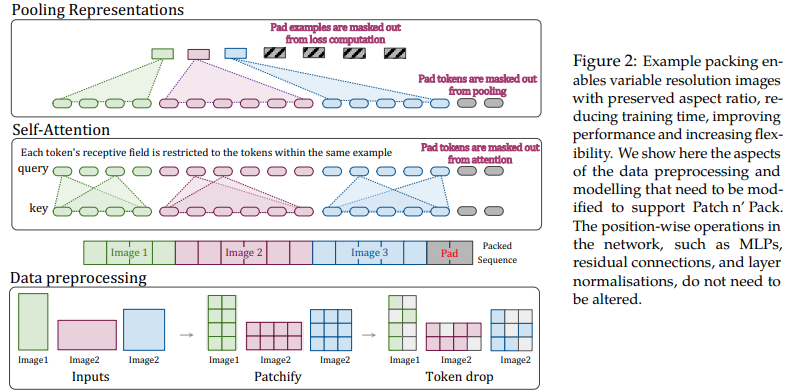
Este artigo propõe aproveitar a flexibilidade de atenção e mascaramento para sequências de comprimento variável para treinar imagens de resolução múltipla, compactadas em um único lote. Eles demonstram treinamento muito mais rápido e maior precisão, sendo o único custo a complexidade extra na arquitetura e no carregamento de dados. Eles usam codificações posicionais 2D fatoradas, eliminação de tokens, bem como normalização de chave de consulta.
Você pode usá-lo da seguinte maneira
import torch
from vit_pytorch . na_vit import NaViT
v = NaViT (
image_size = 256 ,
patch_size = 32 ,
num_classes = 1000 ,
dim = 1024 ,
depth = 6 ,
heads = 16 ,
mlp_dim = 2048 ,
dropout = 0.1 ,
emb_dropout = 0.1 ,
token_dropout_prob = 0.1 # token dropout of 10% (keep 90% of tokens)
)
# 5 images of different resolutions - List[List[Tensor]]
# for now, you'll have to correctly place images in same batch element as to not exceed maximum allowed sequence length for self-attention w/ masking
images = [
[ torch . randn ( 3 , 256 , 256 ), torch . randn ( 3 , 128 , 128 )],
[ torch . randn ( 3 , 128 , 256 ), torch . randn ( 3 , 256 , 128 )],
[ torch . randn ( 3 , 64 , 256 )]
]
preds = v ( images ) # (5, 1000) - 5, because 5 images of different resolution aboveOu se você preferir que a estrutura agrupe automaticamente as imagens em sequências de comprimento variável que não excedam um determinado comprimento máximo
images = [
torch . randn ( 3 , 256 , 256 ),
torch . randn ( 3 , 128 , 128 ),
torch . randn ( 3 , 128 , 256 ),
torch . randn ( 3 , 256 , 128 ),
torch . randn ( 3 , 64 , 256 )
]
preds = v (
images ,
group_images = True ,
group_max_seq_len = 64
) # (5, 1000) Finalmente, se você quiser usar um tipo de NaViT usando tensores aninhados (que omitirão grande parte do mascaramento e preenchimento), certifique-se de estar na versão 2.5 e importe da seguinte maneira
import torch
from vit_pytorch . na_vit_nested_tensor import NaViT
v = NaViT (
image_size = 256 ,
patch_size = 32 ,
num_classes = 1000 ,
dim = 1024 ,
depth = 6 ,
heads = 16 ,
mlp_dim = 2048 ,
dropout = 0. ,
emb_dropout = 0. ,
token_dropout_prob = 0.1
)
# 5 images of different resolutions - List[Tensor]
images = [
torch . randn ( 3 , 256 , 256 ), torch . randn ( 3 , 128 , 128 ),
torch . randn ( 3 , 128 , 256 ), torch . randn ( 3 , 256 , 128 ),
torch . randn ( 3 , 64 , 256 )
]
preds = v ( images )
assert preds . shape == ( 5 , 1000 )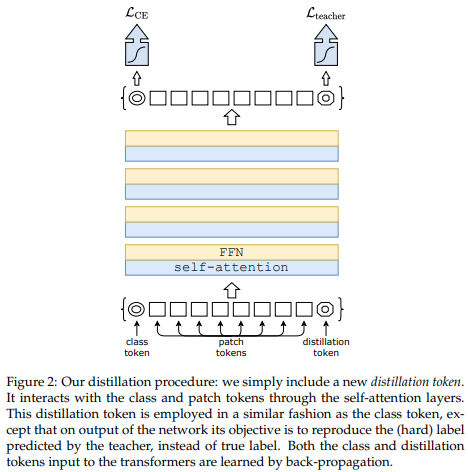
Um artigo recente mostrou que o uso de um token de destilação para destilar conhecimento de redes convolucionais para transformadores de visão pode produzir transformadores de visão pequenos e eficientes. Este repositório oferece meios para fazer a destilação facilmente.
ex. destilando de Resnet50 (ou qualquer professor) para um transformador de visão
import torch
from torchvision . models import resnet50
from vit_pytorch . distill import DistillableViT , DistillWrapper
teacher = resnet50 ( pretrained = True )
v = DistillableViT (
image_size = 256 ,
patch_size = 32 ,
num_classes = 1000 ,
dim = 1024 ,
depth = 6 ,
heads = 8 ,
mlp_dim = 2048 ,
dropout = 0.1 ,
emb_dropout = 0.1
)
distiller = DistillWrapper (
student = v ,
teacher = teacher ,
temperature = 3 , # temperature of distillation
alpha = 0.5 , # trade between main loss and distillation loss
hard = False # whether to use soft or hard distillation
)
img = torch . randn ( 2 , 3 , 256 , 256 )
labels = torch . randint ( 0 , 1000 , ( 2 ,))
loss = distiller ( img , labels )
loss . backward ()
# after lots of training above ...
pred = v ( img ) # (2, 1000) A classe DistillableViT é idêntica à ViT exceto pela maneira como a passagem direta é tratada, portanto, você poderá carregar os parâmetros de volta no ViT depois de concluir o treinamento de destilação.
Você também pode usar o prático método .to_vit na instância DistillableViT para recuperar uma instância ViT .
v = v . to_vit ()
type ( v ) # <class 'vit_pytorch.vit_pytorch.ViT'> Este artigo observa que o ViT se esforça para atender em profundidades maiores (após 12 camadas) e sugere misturar a atenção de cada cabeça pós-softmax como uma solução, chamada de Re-atenção. Os resultados estão alinhados com o artigo Talking Heads da PNL.
Você pode usá-lo da seguinte maneira
import torch
from vit_pytorch . deepvit import DeepViT
v = DeepViT (
image_size = 256 ,
patch_size = 32 ,
num_classes = 1000 ,
dim = 1024 ,
depth = 6 ,
heads = 16 ,
mlp_dim = 2048 ,
dropout = 0.1 ,
emb_dropout = 0.1
)
img = torch . randn ( 1 , 3 , 256 , 256 )
preds = v ( img ) # (1, 1000) Este artigo também observa dificuldade em treinar transformadores de visão em maiores profundidades e propõe duas soluções. Primeiro propõe fazer a multiplicação por canal da saída do bloco residual. Em segundo lugar, propõe que os patches atendam uns aos outros e apenas permita que o token CLS atenda aos patches nas últimas camadas.
Eles também adicionam Talking Heads, observando melhorias
Você pode usar este esquema da seguinte maneira
import torch
from vit_pytorch . cait import CaiT
v = CaiT (
image_size = 256 ,
patch_size = 32 ,
num_classes = 1000 ,
dim = 1024 ,
depth = 12 , # depth of transformer for patch to patch attention only
cls_depth = 2 , # depth of cross attention of CLS tokens to patch
heads = 16 ,
mlp_dim = 2048 ,
dropout = 0.1 ,
emb_dropout = 0.1 ,
layer_dropout = 0.05 # randomly dropout 5% of the layers
)
img = torch . randn ( 1 , 3 , 256 , 256 )
preds = v ( img ) # (1, 1000) 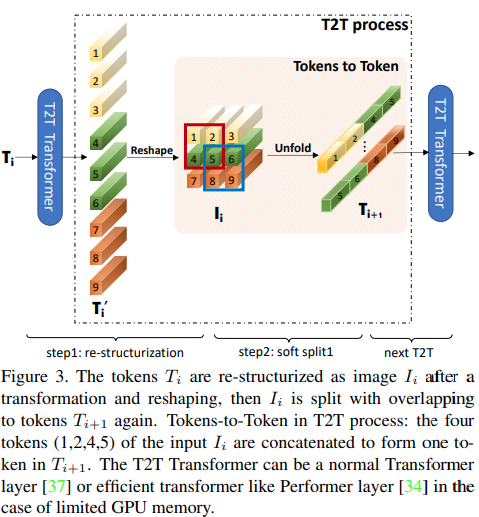
Este artigo propõe que as primeiras camadas reduzam a resolução da sequência de imagens por meio do desdobramento, levando à sobreposição de dados de imagem em cada token, conforme mostrado na figura acima. Você pode usar esta variante do ViT da seguinte maneira.
import torch
from vit_pytorch . t2t import T2TViT
v = T2TViT (
dim = 512 ,
image_size = 224 ,
depth = 5 ,
heads = 8 ,
mlp_dim = 512 ,
num_classes = 1000 ,
t2t_layers = (( 7 , 4 ), ( 3 , 2 ), ( 3 , 2 )) # tuples of the kernel size and stride of each consecutive layers of the initial token to token module
)
img = torch . randn ( 1 , 3 , 224 , 224 )
preds = v ( img ) # (1, 1000) O CCT propõe transformadores compactos usando convoluções em vez de patching e realizando agrupamento de sequências. Isso permite que o CCT tenha alta precisão e um baixo número de parâmetros.
Você pode usar isso com dois métodos
import torch
from vit_pytorch . cct import CCT
cct = CCT (
img_size = ( 224 , 448 ),
embedding_dim = 384 ,
n_conv_layers = 2 ,
kernel_size = 7 ,
stride = 2 ,
padding = 3 ,
pooling_kernel_size = 3 ,
pooling_stride = 2 ,
pooling_padding = 1 ,
num_layers = 14 ,
num_heads = 6 ,
mlp_ratio = 3. ,
num_classes = 1000 ,
positional_embedding = 'learnable' , # ['sine', 'learnable', 'none']
)
img = torch . randn ( 1 , 3 , 224 , 448 )
pred = cct ( img ) # (1, 1000) Alternativamente, você pode usar um dos vários modelos predefinidos [2,4,6,7,8,14,16] que pré-definem o número de camadas, o número de cabeças de atenção, a proporção mlp e a dimensão de incorporação.
import torch
from vit_pytorch . cct import cct_14
cct = cct_14 (
img_size = 224 ,
n_conv_layers = 1 ,
kernel_size = 7 ,
stride = 2 ,
padding = 3 ,
pooling_kernel_size = 3 ,
pooling_stride = 2 ,
pooling_padding = 1 ,
num_classes = 1000 ,
positional_embedding = 'learnable' , # ['sine', 'learnable', 'none']
)O Repositório Oficial inclui links para pontos de verificação de modelos pré-treinados.
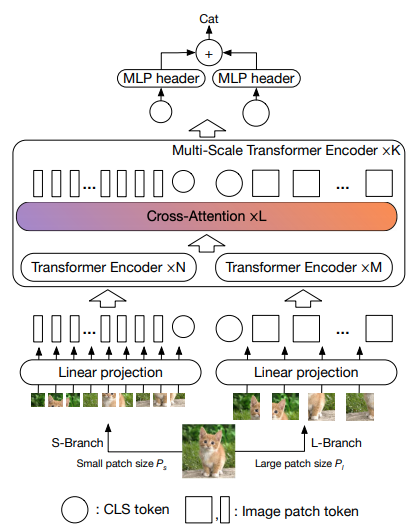
Este artigo propõe ter dois transformadores de visão processando a imagem em escalas diferentes, atendendo um de vez em quando. Eles mostram melhorias no topo do transformador de visão básico.
import torch
from vit_pytorch . cross_vit import CrossViT
v = CrossViT (
image_size = 256 ,
num_classes = 1000 ,
depth = 4 , # number of multi-scale encoding blocks
sm_dim = 192 , # high res dimension
sm_patch_size = 16 , # high res patch size (should be smaller than lg_patch_size)
sm_enc_depth = 2 , # high res depth
sm_enc_heads = 8 , # high res heads
sm_enc_mlp_dim = 2048 , # high res feedforward dimension
lg_dim = 384 , # low res dimension
lg_patch_size = 64 , # low res patch size
lg_enc_depth = 3 , # low res depth
lg_enc_heads = 8 , # low res heads
lg_enc_mlp_dim = 2048 , # low res feedforward dimensions
cross_attn_depth = 2 , # cross attention rounds
cross_attn_heads = 8 , # cross attention heads
dropout = 0.1 ,
emb_dropout = 0.1
)
img = torch . randn ( 1 , 3 , 256 , 256 )
pred = v ( img ) # (1, 1000) 
Este artigo propõe reduzir a resolução dos tokens por meio de um procedimento de agrupamento usando convoluções em profundidade.
import torch
from vit_pytorch . pit import PiT
v = PiT (
image_size = 224 ,
patch_size = 14 ,
dim = 256 ,
num_classes = 1000 ,
depth = ( 3 , 3 , 3 ), # list of depths, indicating the number of rounds of each stage before a downsample
heads = 16 ,
mlp_dim = 2048 ,
dropout = 0.1 ,
emb_dropout = 0.1
)
# forward pass now returns predictions and the attention maps
img = torch . randn ( 1 , 3 , 224 , 224 )
preds = v ( img ) # (1, 1000) 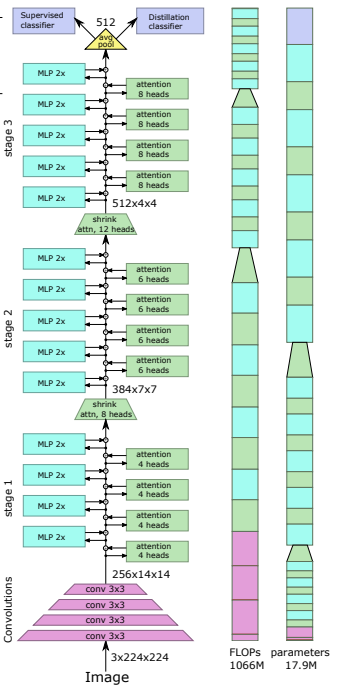
Este artigo propõe uma série de mudanças, incluindo (1) incorporação convolucional em vez de projeção em patches (2) redução da resolução em estágios (3) não linearidade extra na atenção (4) vieses posicionais relativos 2d em vez de viés posicional absoluto inicial (5 ) norma de lote no lugar de norma de camada.
Repositório oficial
import torch
from vit_pytorch . levit import LeViT
levit = LeViT (
image_size = 224 ,
num_classes = 1000 ,
stages = 3 , # number of stages
dim = ( 256 , 384 , 512 ), # dimensions at each stage
depth = 4 , # transformer of depth 4 at each stage
heads = ( 4 , 6 , 8 ), # heads at each stage
mlp_mult = 2 ,
dropout = 0.1
)
img = torch . randn ( 1 , 3 , 224 , 224 )
levit ( img ) # (1, 1000) 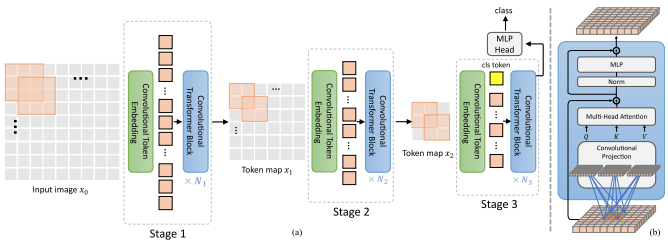
Este artigo propõe misturar circunvoluções e atenção. Especificamente, convoluções são usadas para incorporar e reduzir a resolução da imagem/mapa de recursos em três estágios. A convolução profunda também é usada para projetar as consultas, chaves e valores para atenção.
import torch
from vit_pytorch . cvt import CvT
v = CvT (
num_classes = 1000 ,
s1_emb_dim = 64 , # stage 1 - dimension
s1_emb_kernel = 7 , # stage 1 - conv kernel
s1_emb_stride = 4 , # stage 1 - conv stride
s1_proj_kernel = 3 , # stage 1 - attention ds-conv kernel size
s1_kv_proj_stride = 2 , # stage 1 - attention key / value projection stride
s1_heads = 1 , # stage 1 - heads
s1_depth = 1 , # stage 1 - depth
s1_mlp_mult = 4 , # stage 1 - feedforward expansion factor
s2_emb_dim = 192 , # stage 2 - (same as above)
s2_emb_kernel = 3 ,
s2_emb_stride = 2 ,
s2_proj_kernel = 3 ,
s2_kv_proj_stride = 2 ,
s2_heads = 3 ,
s2_depth = 2 ,
s2_mlp_mult = 4 ,
s3_emb_dim = 384 , # stage 3 - (same as above)
s3_emb_kernel = 3 ,
s3_emb_stride = 2 ,
s3_proj_kernel = 3 ,
s3_kv_proj_stride = 2 ,
s3_heads = 4 ,
s3_depth = 10 ,
s3_mlp_mult = 4 ,
dropout = 0.
)
img = torch . randn ( 1 , 3 , 224 , 224 )
pred = v ( img ) # (1, 1000) 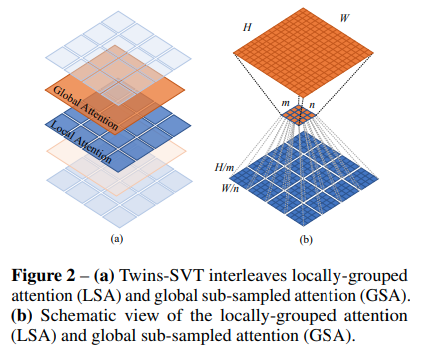
Este artigo propõe misturar atenção local e global, juntamente com gerador de codificação de posição (proposto no CPVT) e pooling de média global, para alcançar os mesmos resultados que o Swin, sem a complexidade extra de janelas deslocadas, tokens CLS, nem incorporações posicionais.
import torch
from vit_pytorch . twins_svt import TwinsSVT
model = TwinsSVT (
num_classes = 1000 , # number of output classes
s1_emb_dim = 64 , # stage 1 - patch embedding projected dimension
s1_patch_size = 4 , # stage 1 - patch size for patch embedding
s1_local_patch_size = 7 , # stage 1 - patch size for local attention
s1_global_k = 7 , # stage 1 - global attention key / value reduction factor, defaults to 7 as specified in paper
s1_depth = 1 , # stage 1 - number of transformer blocks (local attn -> ff -> global attn -> ff)
s2_emb_dim = 128 , # stage 2 (same as above)
s2_patch_size = 2 ,
s2_local_patch_size = 7 ,
s2_global_k = 7 ,
s2_depth = 1 ,
s3_emb_dim = 256 , # stage 3 (same as above)
s3_patch_size = 2 ,
s3_local_patch_size = 7 ,
s3_global_k = 7 ,
s3_depth = 5 ,
s4_emb_dim = 512 , # stage 4 (same as above)
s4_patch_size = 2 ,
s4_local_patch_size = 7 ,
s4_global_k = 7 ,
s4_depth = 4 ,
peg_kernel_size = 3 , # positional encoding generator kernel size
dropout = 0. # dropout
)
img = torch . randn ( 1 , 3 , 224 , 224 )
pred = model ( img ) # (1, 1000) 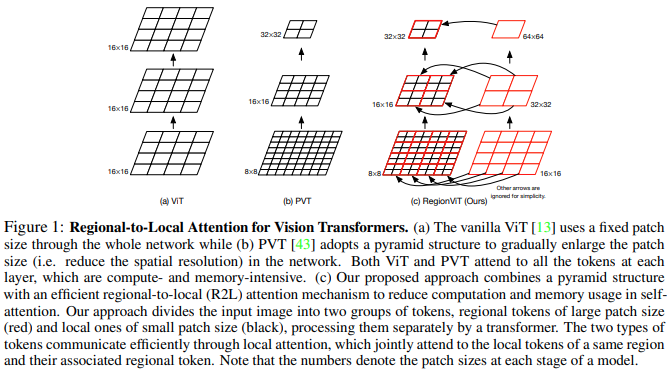
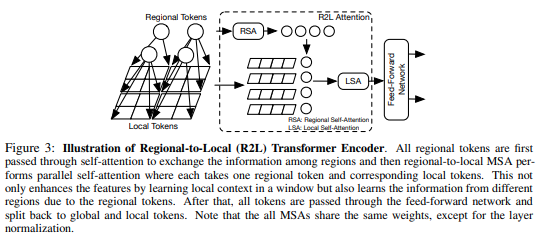
Este artigo propõe dividir o mapa de características em regiões locais, onde os tokens locais atendem uns aos outros. Cada região local possui seu próprio token regional que atende todos os seus tokens locais, bem como outros tokens regionais.
Você pode usá-lo da seguinte maneira
import torch
from vit_pytorch . regionvit import RegionViT
model = RegionViT (
dim = ( 64 , 128 , 256 , 512 ), # tuple of size 4, indicating dimension at each stage
depth = ( 2 , 2 , 8 , 2 ), # depth of the region to local transformer at each stage
window_size = 7 , # window size, which should be either 7 or 14
num_classes = 1000 , # number of output classes
tokenize_local_3_conv = False , # whether to use a 3 layer convolution to encode the local tokens from the image. the paper uses this for the smaller models, but uses only 1 conv (set to False) for the larger models
use_peg = False , # whether to use positional generating module. they used this for object detection for a boost in performance
)
img = torch . randn ( 1 , 3 , 224 , 224 )
pred = model ( img ) # (1, 1000) 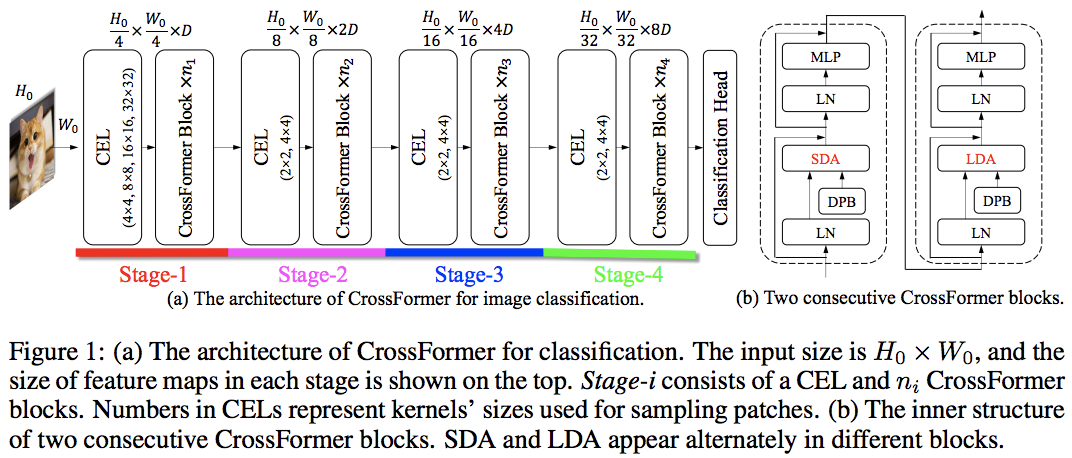
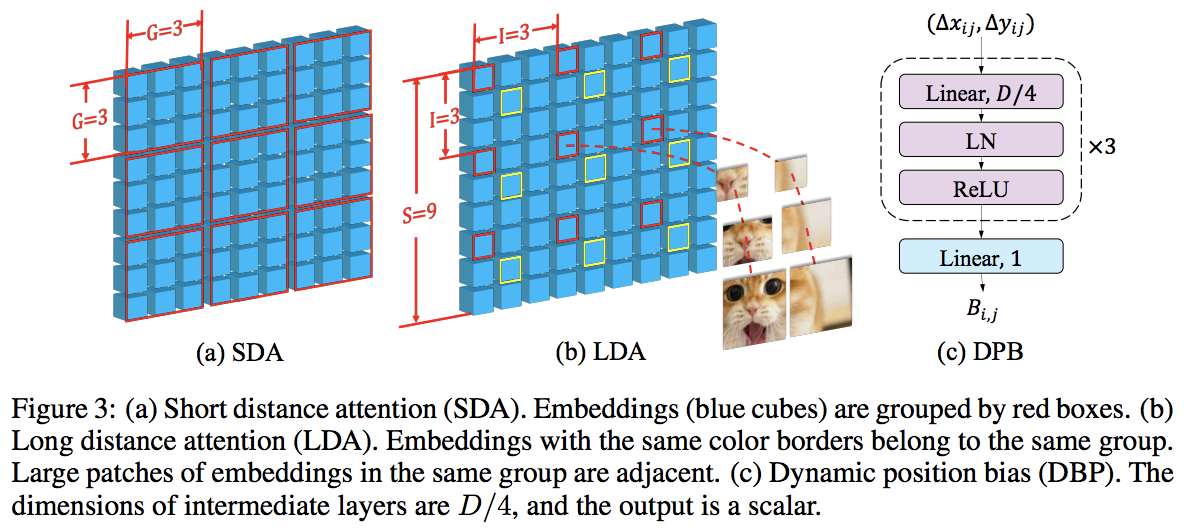
Este artigo supera o PVT e o Swin usando a alternância de atenção local e global. A atenção global é feita através da dimensão de janelas para reduzir a complexidade, de forma muito semelhante ao esquema usado para atenção axial.
Eles também possuem uma camada de incorporação em escala cruzada, que demonstraram ser uma camada genérica que pode melhorar todos os transformadores de visão. O viés posicional relativo dinâmico também foi formulado para permitir que a rede generalizasse para imagens de maior resolução.
import torch
from vit_pytorch . crossformer import CrossFormer
model = CrossFormer (
num_classes = 1000 , # number of output classes
dim = ( 64 , 128 , 256 , 512 ), # dimension at each stage
depth = ( 2 , 2 , 8 , 2 ), # depth of transformer at each stage
global_window_size = ( 8 , 4 , 2 , 1 ), # global window sizes at each stage
local_window_size = 7 , # local window size (can be customized for each stage, but in paper, held constant at 7 for all stages)
)
img = torch . randn ( 1 , 3 , 224 , 224 )
pred = model ( img ) # (1, 1000) 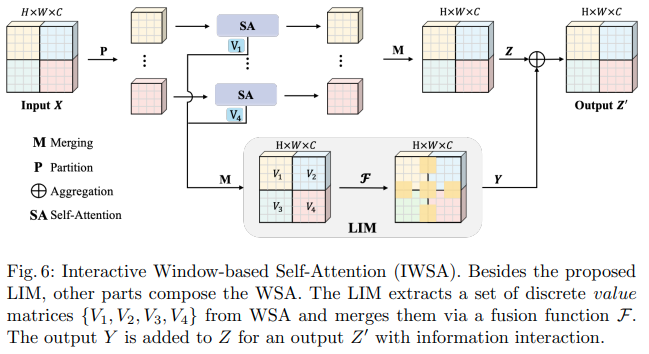
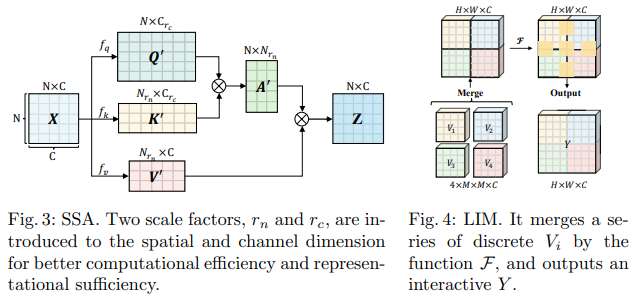
Este artigo da Bytedance AI propõe os módulos Scalable Self Attention (SSA) e Interactive Windowed Self Attention (IWSA). O SSA alivia a computação necessária nos estágios iniciais, reduzindo o mapa de recursos chave/valor em algum fator ( reduction_factor ), enquanto modula a dimensão das consultas e chaves ( ssa_dim_key ). A IWSA realiza autoatenção em janelas locais, semelhante a outros papéis transformadores de visão. No entanto, eles adicionam um resíduo dos valores, passado por uma convolução de tamanho de kernel 3, que eles chamaram de Módulo Interativo Local (LIM).
Eles afirmam neste artigo que este esquema supera o Swin Transformer e também demonstram desempenho competitivo em relação ao Crossformer.
Você pode usá-lo da seguinte maneira (ex. ScalableViT-S)
import torch
from vit_pytorch . scalable_vit import ScalableViT
model = ScalableViT (
num_classes = 1000 ,
dim = 64 , # starting model dimension. at every stage, dimension is doubled
heads = ( 2 , 4 , 8 , 16 ), # number of attention heads at each stage
depth = ( 2 , 2 , 20 , 2 ), # number of transformer blocks at each stage
ssa_dim_key = ( 40 , 40 , 40 , 32 ), # the dimension of the attention keys (and queries) for SSA. in the paper, they represented this as a scale factor on the base dimension per key (ssa_dim_key / dim_key)
reduction_factor = ( 8 , 4 , 2 , 1 ), # downsampling of the key / values in SSA. in the paper, this was represented as (reduction_factor ** -2)
window_size = ( 64 , 32 , None , None ), # window size of the IWSA at each stage. None means no windowing needed
dropout = 0.1 , # attention and feedforward dropout
)
img = torch . randn ( 1 , 3 , 256 , 256 )
preds = model ( img ) # (1, 1000) 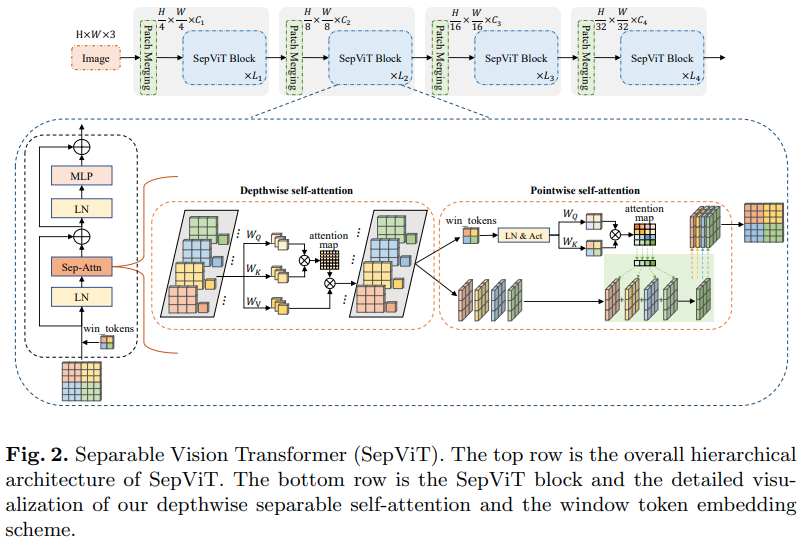
Outro artigo da Bytedance AI propõe uma camada de autoatenção em profundidade e ponto que parece amplamente inspirada na convolução separável em profundidade da rede móvel. O aspecto mais interessante é a reutilização do mapa de características do estágio de autoatenção em profundidade como os valores para a autoatenção pontual, conforme mostrado no diagrama acima.
Decidi incluir apenas a versão do SepViT com esta camada específica de autoatenção, já que as camadas de atenção agrupadas não são notáveis nem novas, e os autores não foram claros sobre como trataram os tokens de janela para a camada de autoatenção de grupo. Além disso, parece que apenas com a camada DSSA eles conseguiram derrotar o Swin.
ex. SepViT-Lite
import torch
from vit_pytorch . sep_vit import SepViT
v = SepViT (
num_classes = 1000 ,
dim = 32 , # dimensions of first stage, which doubles every stage (32, 64, 128, 256) for SepViT-Lite
dim_head = 32 , # attention head dimension
heads = ( 1 , 2 , 4 , 8 ), # number of heads per stage
depth = ( 1 , 2 , 6 , 2 ), # number of transformer blocks per stage
window_size = 7 , # window size of DSS Attention block
dropout = 0.1 # dropout
)
img = torch . randn ( 1 , 3 , 224 , 224 )
preds = v ( img ) # (1, 1000) 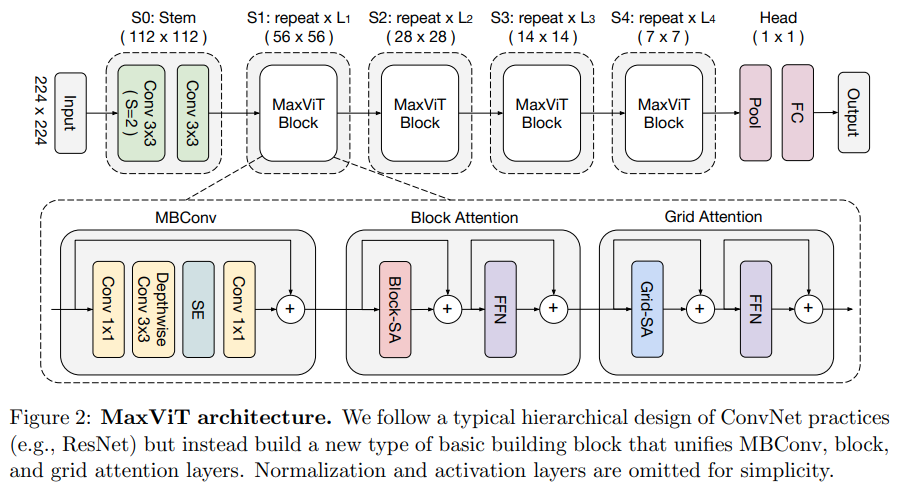
Este artigo propõe uma rede híbrida convolucional/atenção, usando MBConv do lado da convolução e, em seguida, bloco/grade de atenção esparsa axial.
Eles também afirmam que este transformador de visão específico é bom para modelos generativos (GANs).
ex. MaxViT-S
import torch
from vit_pytorch . max_vit import MaxViT
v = MaxViT (
num_classes = 1000 ,
dim_conv_stem = 64 , # dimension of the convolutional stem, would default to dimension of first layer if not specified
dim = 96 , # dimension of first layer, doubles every layer
dim_head = 32 , # dimension of attention heads, kept at 32 in paper
depth = ( 2 , 2 , 5 , 2 ), # number of MaxViT blocks per stage, which consists of MBConv, block-like attention, grid-like attention
window_size = 7 , # window size for block and grids
mbconv_expansion_rate = 4 , # expansion rate of MBConv
mbconv_shrinkage_rate = 0.25 , # shrinkage rate of squeeze-excitation in MBConv
dropout = 0.1 # dropout
)
img = torch . randn ( 2 , 3 , 224 , 224 )
preds = v ( img ) # (2, 1000) 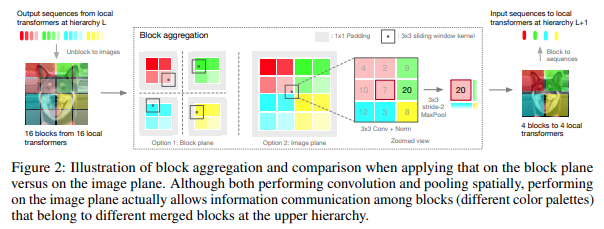
Este artigo decidiu processar a imagem em estágios hierárquicos, com atenção apenas dentro dos tokens dos blocos locais, que se agregam à medida que sobem na hierarquia. A agregação é feita no plano da imagem e contém uma convolução e um maxpool subsequente para permitir a passagem de informações através do limite.
Você pode usá-lo com o seguinte código (ex. NesT-T)
import torch
from vit_pytorch . nest import NesT
nest = NesT (
image_size = 224 ,
patch_size = 4 ,
dim = 96 ,
heads = 3 ,
num_hierarchies = 3 , # number of hierarchies
block_repeats = ( 2 , 2 , 8 ), # the number of transformer blocks at each hierarchy, starting from the bottom
num_classes = 1000
)
img = torch . randn ( 1 , 3 , 224 , 224 )
pred = nest ( img ) # (1, 1000) 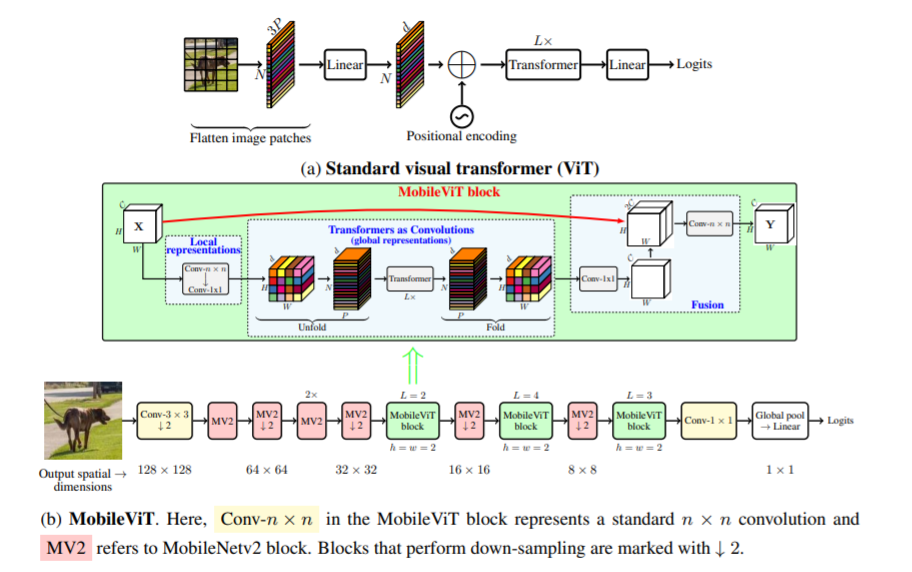
Este artigo apresenta o MobileViT, um transformador de visão leve e de uso geral para dispositivos móveis. MobileViT apresenta uma perspectiva diferente para o processamento global de informações com transformadores.
Você pode usá-lo com o seguinte código (ex. mobilevit_xs)
import torch
from vit_pytorch . mobile_vit import MobileViT
mbvit_xs = MobileViT (
image_size = ( 256 , 256 ),
dims = [ 96 , 120 , 144 ],
channels = [ 16 , 32 , 48 , 48 , 64 , 64 , 80 , 80 , 96 , 96 , 384 ],
num_classes = 1000
)
img = torch . randn ( 1 , 3 , 256 , 256 )
pred = mbvit_xs ( img ) # (1, 1000) 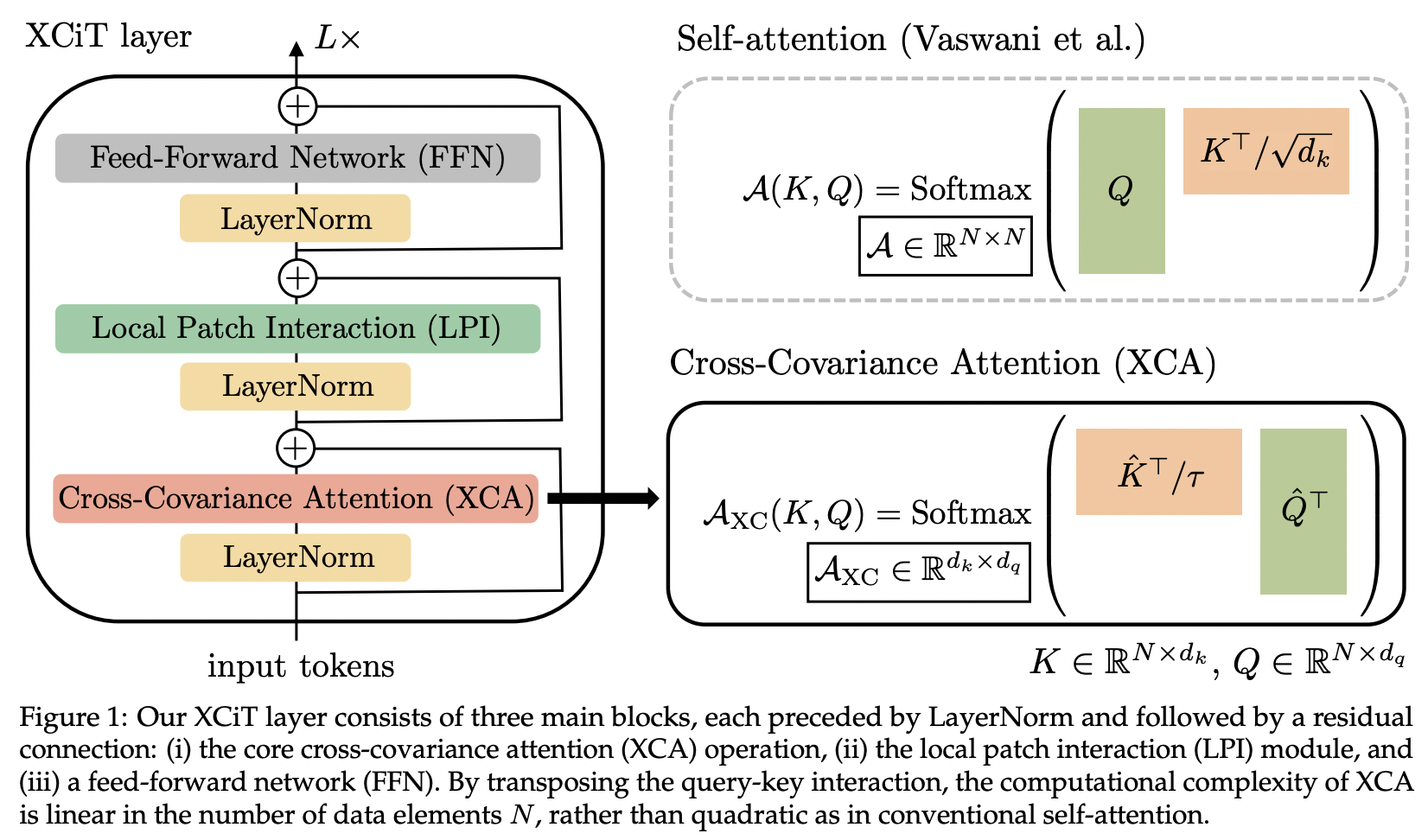
Este artigo apresenta a atenção de covariância cruzada (abreviada como XCA). Pode-se pensar nisso como prestar atenção na dimensão dos recursos, e não na dimensão espacial (outra perspectiva seria uma convolução dinâmica 1x1, sendo o núcleo um mapa de atenção definido por correlações espaciais).
Tecnicamente, isso equivale a simplesmente transpor os valores da consulta, da chave, antes de executar a atenção de similaridade de cosseno com a temperatura aprendida.
import torch
from vit_pytorch . xcit import XCiT
v = XCiT (
image_size = 256 ,
patch_size = 32 ,
num_classes = 1000 ,
dim = 1024 ,
depth = 12 , # depth of xcit transformer
cls_depth = 2 , # depth of cross attention of CLS tokens to patch, attention pool at end
heads = 16 ,
mlp_dim = 2048 ,
dropout = 0.1 ,
emb_dropout = 0.1 ,
layer_dropout = 0.05 , # randomly dropout 5% of the layers
local_patch_kernel_size = 3 # kernel size of the local patch interaction module (depthwise convs)
)
img = torch . randn ( 1 , 3 , 256 , 256 )
preds = v ( img ) # (1, 1000) 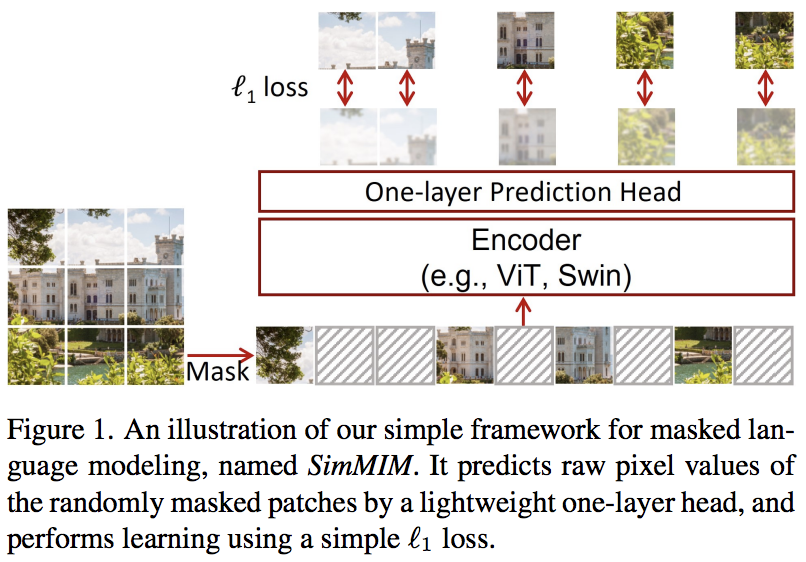
Este artigo propõe um esquema simples de modelagem de imagem mascarada (SimMIM), usando apenas uma projeção linear dos tokens mascarados no espaço de pixels seguida por uma perda L1 com os valores de pixel dos patches mascarados. Os resultados são competitivos com outras abordagens mais complicadas.
Você pode usar isso da seguinte maneira
import torch
from vit_pytorch import ViT
from vit_pytorch . simmim import SimMIM
v = ViT (
image_size = 256 ,
patch_size = 32 ,
num_classes = 1000 ,
dim = 1024 ,
depth = 6 ,
heads = 8 ,
mlp_dim = 2048
)
mim = SimMIM (
encoder = v ,
masking_ratio = 0.5 # they found 50% to yield the best results
)
images = torch . randn ( 8 , 3 , 256 , 256 )
loss = mim ( images )
loss . backward ()
# that's all!
# do the above in a for loop many times with a lot of images and your vision transformer will learn
torch . save ( v . state_dict (), './trained-vit.pt' )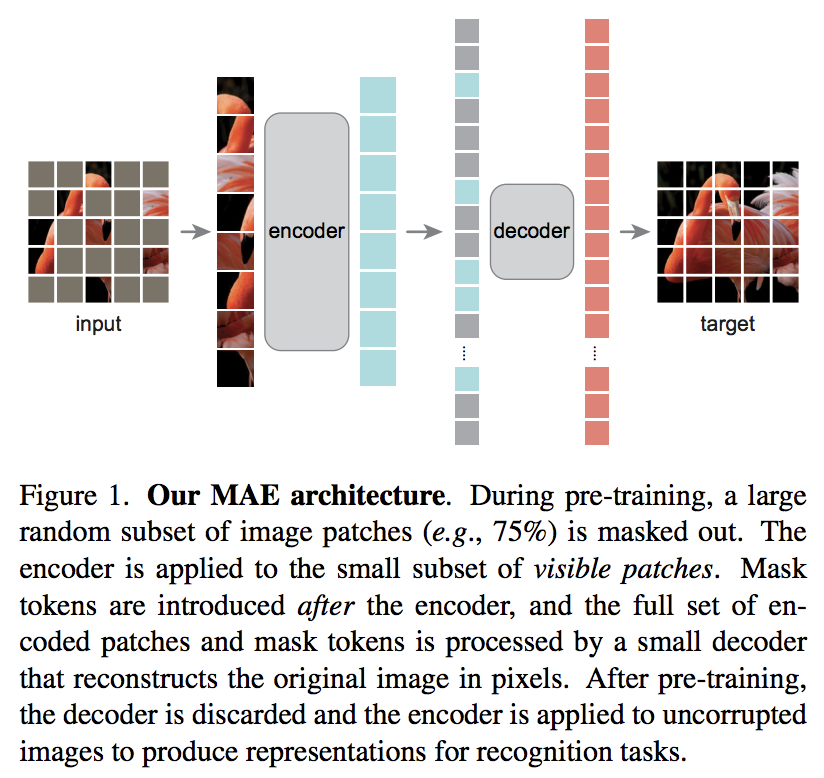
Um novo artigo de Kaiming He propõe um esquema de autoencoder simples onde o transformador de visão atende a um conjunto de patches não mascarados e um decodificador menor tenta reconstruir os valores de pixel mascarados.
Revisão rápida do artigo do DeepReader
AI Coffeebreak com Letitia
Você pode usá-lo com o seguinte código
import torch
from vit_pytorch import ViT , MAE
v = ViT (
image_size = 256 ,
patch_size = 32 ,
num_classes = 1000 ,
dim = 1024 ,
depth = 6 ,
heads = 8 ,
mlp_dim = 2048
)
mae = MAE (
encoder = v ,
masking_ratio = 0.75 , # the paper recommended 75% masked patches
decoder_dim = 512 , # paper showed good results with just 512
decoder_depth = 6 # anywhere from 1 to 8
)
images = torch . randn ( 8 , 3 , 256 , 256 )
loss = mae ( images )
loss . backward ()
# that's all!
# do the above in a for loop many times with a lot of images and your vision transformer will learn
# save your improved vision transformer
torch . save ( v . state_dict (), './trained-vit.pt' )Graças a Zach, você pode treinar usando a tarefa original de previsão de patch mascarado apresentada no artigo, com o código a seguir.
import torch
from vit_pytorch import ViT
from vit_pytorch . mpp import MPP
model = ViT (
image_size = 256 ,
patch_size = 32 ,
num_classes = 1000 ,
dim = 1024 ,
depth = 6 ,
heads = 8 ,
mlp_dim = 2048 ,
dropout = 0.1 ,
emb_dropout = 0.1
)
mpp_trainer = MPP (
transformer = model ,
patch_size = 32 ,
dim = 1024 ,
mask_prob = 0.15 , # probability of using token in masked prediction task
random_patch_prob = 0.30 , # probability of randomly replacing a token being used for mpp
replace_prob = 0.50 , # probability of replacing a token being used for mpp with the mask token
)
opt = torch . optim . Adam ( mpp_trainer . parameters (), lr = 3e-4 )
def sample_unlabelled_images ():
return torch . FloatTensor ( 20 , 3 , 256 , 256 ). uniform_ ( 0. , 1. )
for _ in range ( 100 ):
images = sample_unlabelled_images ()
loss = mpp_trainer ( images )
opt . zero_grad ()
loss . backward ()
opt . step ()
# save your improved network
torch . save ( model . state_dict (), './pretrained-net.pt' )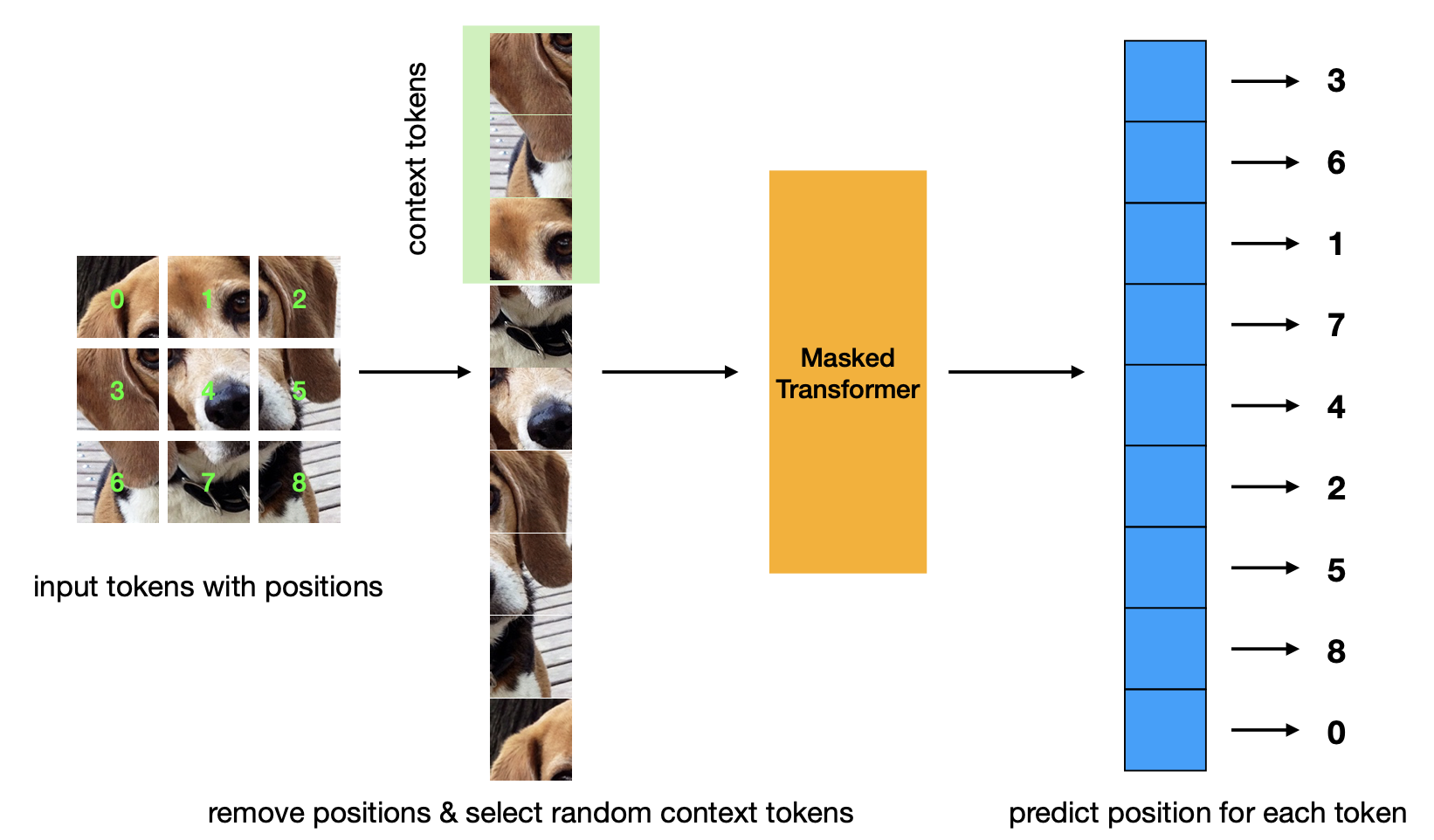
Novo artigo que apresenta critérios de pré-treinamento de previsão de posição mascarada. Esta estratégia é mais eficiente que a estratégia Masked Autoencoder e tem desempenho comparável.
import torch
from vit_pytorch . mp3 import ViT , MP3
v = ViT (
num_classes = 1000 ,
image_size = 256 ,
patch_size = 8 ,
dim = 1024 ,
depth = 6 ,
heads = 8 ,
mlp_dim = 2048 ,
dropout = 0.1 ,
)
mp3 = MP3 (
vit = v ,
masking_ratio = 0.75
)
images = torch . randn ( 8 , 3 , 256 , 256 )
loss = mp3 ( images )
loss . backward ()
# that's all!
# do the above in a for loop many times with a lot of images and your vision transformer will learn
# save your improved vision transformer
torch . save ( v . state_dict (), './trained-vit.pt' )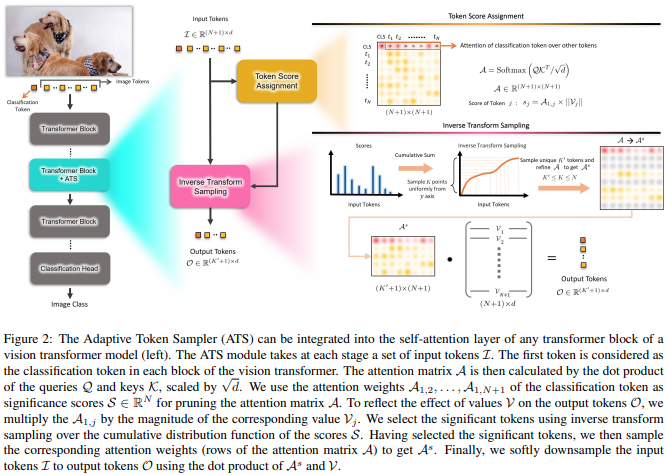
Este artigo propõe usar as pontuações de atenção do CLS, reponderadas pelas normas das cabeças de valor, como meio de descartar tokens sem importância em diferentes camadas.
import torch
from vit_pytorch . ats_vit import ViT
v = ViT (
image_size = 256 ,
patch_size = 16 ,
num_classes = 1000 ,
dim = 1024 ,
depth = 6 ,
max_tokens_per_depth = ( 256 , 128 , 64 , 32 , 16 , 8 ), # a tuple that denotes the maximum number of tokens that any given layer should have. if the layer has greater than this amount, it will undergo adaptive token sampling
heads = 16 ,
mlp_dim = 2048 ,
dropout = 0.1 ,
emb_dropout = 0.1
)
img = torch . randn ( 4 , 3 , 256 , 256 )
preds = v ( img ) # (4, 1000)
# you can also get a list of the final sampled patch ids
# a value of -1 denotes padding
preds , token_ids = v ( img , return_sampled_token_ids = True ) # (4, 1000), (4, <=8) 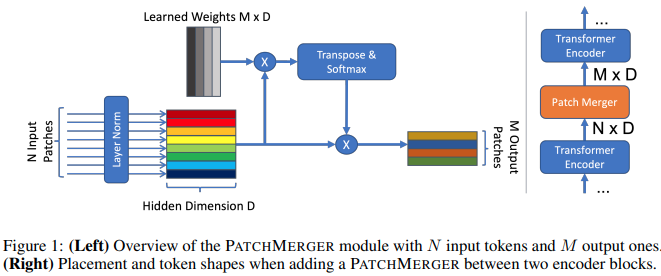
Este artigo propõe um módulo simples (Patch Merger) para reduzir o número de tokens em qualquer camada de um transformador de visão sem sacrificar o desempenho.
import torch
from vit_pytorch . vit_with_patch_merger import ViT
v = ViT (
image_size = 256 ,
patch_size = 16 ,
num_classes = 1000 ,
dim = 1024 ,
depth = 12 ,
heads = 8 ,
patch_merge_layer = 6 , # at which transformer layer to do patch merging
patch_merge_num_tokens = 8 , # the output number of tokens from the patch merge
mlp_dim = 2048 ,
dropout = 0.1 ,
emb_dropout = 0.1
)
img = torch . randn ( 4 , 3 , 256 , 256 )
preds = v ( img ) # (4, 1000) Também é possível usar o módulo PatchMerger sozinho
import torch
from vit_pytorch . vit_with_patch_merger import PatchMerger
merger = PatchMerger (
dim = 1024 ,
num_tokens_out = 8 # output number of tokens
)
features = torch . randn ( 4 , 256 , 1024 ) # (batch, num tokens, dimension)
out = merger ( features ) # (4, 8, 1024) 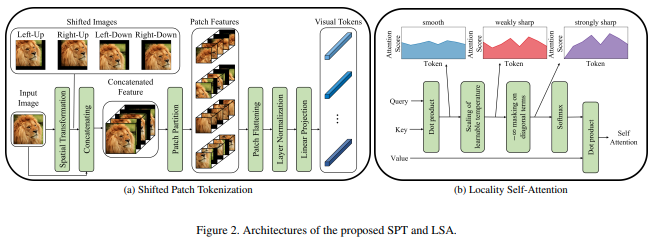
Este artigo propõe uma nova função de patch de imagem que incorpora mudanças na imagem, antes de normalizar e dividir a imagem em patches. Achei a mudança extremamente útil em alguns outros trabalhos de transformadores, então decidi incluí-la para futuras explorações. Também inclui o LSA com a temperatura aprendida e mascarando a atenção de um token para si mesmo.
Você pode usar da seguinte forma:
import torch
from vit_pytorch . vit_for_small_dataset import ViT
v = ViT (
image_size = 256 ,
patch_size = 16 ,
num_classes = 1000 ,
dim = 1024 ,
depth = 6 ,
heads = 16 ,
mlp_dim = 2048 ,
dropout = 0.1 ,
emb_dropout = 0.1
)
img = torch . randn ( 4 , 3 , 256 , 256 )
preds = v ( img ) # (1, 1000) Você também pode usar o SPT deste documento como um módulo independente
import torch
from vit_pytorch . vit_for_small_dataset import SPT
spt = SPT (
dim = 1024 ,
patch_size = 16 ,
channels = 3
)
img = torch . randn ( 4 , 3 , 256 , 256 )
tokens = spt ( img ) # (4, 256, 1024) A pedido popular, começarei a estender algumas das arquiteturas deste repositório para ViTs 3D, para uso com vídeo, imagens médicas, etc.
Você precisará passar dois hiperparâmetros adicionais: (1) o número de frames e (2) o tamanho do patch ao longo da dimensão do quadro frame_patch_size
Para começar, 3D ViT
import torch
from vit_pytorch . vit_3d import ViT
v = ViT (
image_size = 128 , # image size
frames = 16 , # number of frames
image_patch_size = 16 , # image patch size
frame_patch_size = 2 , # frame patch size
num_classes = 1000 ,
dim = 1024 ,
depth = 6 ,
heads = 8 ,
mlp_dim = 2048 ,
dropout = 0.1 ,
emb_dropout = 0.1
)
video = torch . randn ( 4 , 3 , 16 , 128 , 128 ) # (batch, channels, frames, height, width)
preds = v ( video ) # (4, 1000)ViT simples 3D
import torch
from vit_pytorch . simple_vit_3d import SimpleViT
v = SimpleViT (
image_size = 128 , # image size
frames = 16 , # number of frames
image_patch_size = 16 , # image patch size
frame_patch_size = 2 , # frame patch size
num_classes = 1000 ,
dim = 1024 ,
depth = 6 ,
heads = 8 ,
mlp_dim = 2048
)
video = torch . randn ( 4 , 3 , 16 , 128 , 128 ) # (batch, channels, frames, height, width)
preds = v ( video ) # (4, 1000)Versão 3D do CCT
import torch
from vit_pytorch . cct_3d import CCT
cct = CCT (
img_size = 224 ,
num_frames = 8 ,
embedding_dim = 384 ,
n_conv_layers = 2 ,
frame_kernel_size = 3 ,
kernel_size = 7 ,
stride = 2 ,
padding = 3 ,
pooling_kernel_size = 3 ,
pooling_stride = 2 ,
pooling_padding = 1 ,
num_layers = 14 ,
num_heads = 6 ,
mlp_ratio = 3. ,
num_classes = 1000 ,
positional_embedding = 'learnable'
)
video = torch . randn ( 1 , 3 , 8 , 224 , 224 ) # (batch, channels, frames, height, width)
pred = cct ( video )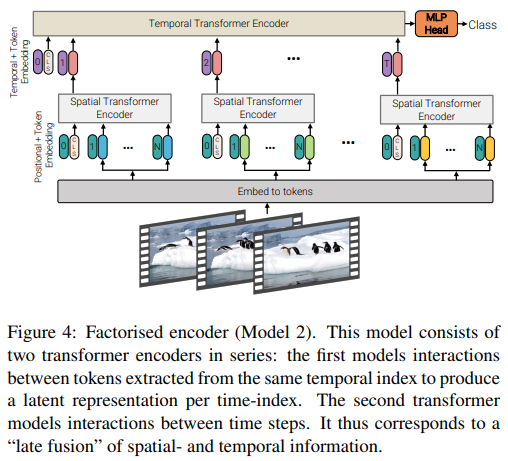
Este artigo oferece 3 tipos diferentes de arquiteturas para atenção eficiente de vídeos, tendo como tema principal a fatoração da atenção no espaço e no tempo. Este repositório inclui o codificador fatorado e a variante de autoatenção fatorada. A variante do codificador fatorado é um transformador espacial seguido por um temporal. A variante de autoatenção fatorada é um transformador espaço-temporal com camadas alternadas de autoatenção espacial e temporal.
import torch
from vit_pytorch . vivit import ViT
v = ViT (
image_size = 128 , # image size
frames = 16 , # number of frames
image_patch_size = 16 , # image patch size
frame_patch_size = 2 , # frame patch size
num_classes = 1000 ,
dim = 1024 ,
spatial_depth = 6 , # depth of the spatial transformer
temporal_depth = 6 , # depth of the temporal transformer
heads = 8 ,
mlp_dim = 2048 ,
variant = 'factorized_encoder' , # or 'factorized_self_attention'
)
video = torch . randn ( 4 , 3 , 16 , 128 , 128 ) # (batch, channels, frames, height, width)
preds = v ( video ) # (4, 1000) 
Este artigo propõe paralelizar vários blocos de atenção e feedforward por camada (2 blocos), alegando que é mais fácil treinar sem perda de desempenho.
Você pode tentar esta variante da seguinte maneira
import torch
from vit_pytorch . parallel_vit import ViT
v = ViT (
image_size = 256 ,
patch_size = 16 ,
num_classes = 1000 ,
dim = 1024 ,
depth = 6 ,
heads = 8 ,
mlp_dim = 2048 ,
num_parallel_branches = 2 , # in paper, they claimed 2 was optimal
dropout = 0.1 ,
emb_dropout = 0.1
)
img = torch . randn ( 4 , 3 , 256 , 256 )
preds = v ( img ) # (4, 1000) 
Este artigo mostra que adicionar tokens de memória que podem ser aprendidos em cada camada de um transformador de visão pode melhorar muito os resultados de ajuste fino (além do token CLS específico da tarefa que pode ser aprendida e do cabeçote do adaptador).
Você pode usar isso com um ViT especialmente modificado da seguinte maneira
import torch
from vit_pytorch . learnable_memory_vit import ViT , Adapter
# normal base ViT
v = ViT (
image_size = 256 ,
patch_size = 16 ,
num_classes = 1000 ,
dim = 1024 ,
depth = 6 ,
heads = 8 ,
mlp_dim = 2048 ,
dropout = 0.1 ,
emb_dropout = 0.1
)
img = torch . randn ( 4 , 3 , 256 , 256 )
logits = v ( img ) # (4, 1000)
# do your usual training with ViT
# ...
# then, to finetune, just pass the ViT into the Adapter class
# you can do this for multiple Adapters, as shown below
adapter1 = Adapter (
vit = v ,
num_classes = 2 , # number of output classes for this specific task
num_memories_per_layer = 5 # number of learnable memories per layer, 10 was sufficient in paper
)
logits1 = adapter1 ( img ) # (4, 2) - predict 2 classes off frozen ViT backbone with learnable memories and task specific head
# yet another task to finetune on, this time with 4 classes
adapter2 = Adapter (
vit = v ,
num_classes = 4 ,
num_memories_per_layer = 10
)
logits2 = adapter2 ( img ) # (4, 4) - predict 4 classes off frozen ViT backbone with learnable memories and task specific head 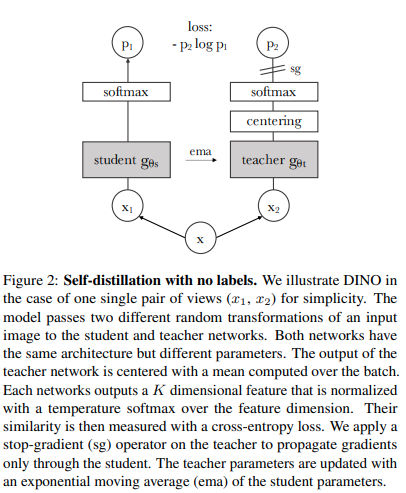
Você pode treinar ViT com a recente técnica de aprendizagem auto-supervisionada SOTA, Dino, com o código a seguir.
Vídeo de Yannic Kilcher
import torch
from vit_pytorch import ViT , Dino
model = ViT (
image_size = 256 ,
patch_size = 32 ,
num_classes = 1000 ,
dim = 1024 ,
depth = 6 ,
heads = 8 ,
mlp_dim = 2048
)
learner = Dino (
model ,
image_size = 256 ,
hidden_layer = 'to_latent' , # hidden layer name or index, from which to extract the embedding
projection_hidden_size = 256 , # projector network hidden dimension
projection_layers = 4 , # number of layers in projection network
num_classes_K = 65336 , # output logits dimensions (referenced as K in paper)
student_temp = 0.9 , # student temperature
teacher_temp = 0.04 , # teacher temperature, needs to be annealed from 0.04 to 0.07 over 30 epochs
local_upper_crop_scale = 0.4 , # upper bound for local crop - 0.4 was recommended in the paper
global_lower_crop_scale = 0.5 , # lower bound for global crop - 0.5 was recommended in the paper
moving_average_decay = 0.9 , # moving average of encoder - paper showed anywhere from 0.9 to 0.999 was ok
center_moving_average_decay = 0.9 , # moving average of teacher centers - paper showed anywhere from 0.9 to 0.999 was ok
)
opt = torch . optim . Adam ( learner . parameters (), lr = 3e-4 )
def sample_unlabelled_images ():
return torch . randn ( 20 , 3 , 256 , 256 )
for _ in range ( 100 ):
images = sample_unlabelled_images ()
loss = learner ( images )
opt . zero_grad ()
loss . backward ()
opt . step ()
learner . update_moving_average () # update moving average of teacher encoder and teacher centers
# save your improved network
torch . save ( model . state_dict (), './pretrained-net.pt' )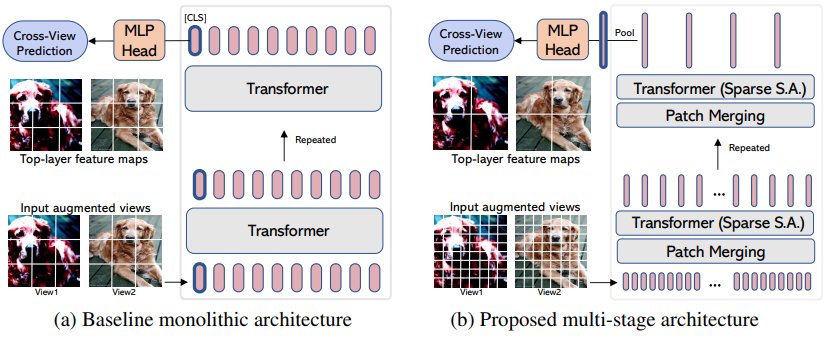
EsViT é uma variante do Dino (de cima) reprojetada para suportar ViT s eficientes com fusão/redução da resolução de patches, levando em consideração uma perda regional extra entre as visualizações aumentadas. Para citar o resumo, ele outperforms its supervised counterpart on 17 out of 18 datasets com rendimento 3 vezes maior.
Embora seja nomeado como se fosse uma nova variante ViT , na verdade é apenas uma estratégia para treinar qualquer ViT de vários estágios (no artigo, eles se concentraram no Swin). O exemplo abaixo mostrará como usá-lo com CvT . Você precisará definir a hidden_layer como o nome da camada em seu ViT eficiente que gera as representações visuais agrupadas não médias, pouco antes do agrupamento global e da projeção para logits.
import torch
from vit_pytorch . cvt import CvT
from vit_pytorch . es_vit import EsViTTrainer
cvt = CvT (
num_classes = 1000 ,
s1_emb_dim = 64 ,
s1_emb_kernel = 7 ,
s1_emb_stride = 4 ,
s1_proj_kernel = 3 ,
s1_kv_proj_stride = 2 ,
s1_heads = 1 ,
s1_depth = 1 ,
s1_mlp_mult = 4 ,
s2_emb_dim = 192 ,
s2_emb_kernel = 3 ,
s2_emb_stride = 2 ,
s2_proj_kernel = 3 ,
s2_kv_proj_stride = 2 ,
s2_heads = 3 ,
s2_depth = 2 ,
s2_mlp_mult = 4 ,
s3_emb_dim = 384 ,
s3_emb_kernel = 3 ,
s3_emb_stride = 2 ,
s3_proj_kernel = 3 ,
s3_kv_proj_stride = 2 ,
s3_heads = 4 ,
s3_depth = 10 ,
s3_mlp_mult = 4 ,
dropout = 0.
)
learner = EsViTTrainer (
cvt ,
image_size = 256 ,
hidden_layer = 'layers' , # hidden layer name or index, from which to extract the embedding
projection_hidden_size = 256 , # projector network hidden dimension
projection_layers = 4 , # number of layers in projection network
num_classes_K = 65336 , # output logits dimensions (referenced as K in paper)
student_temp = 0.9 , # student temperature
teacher_temp = 0.04 , # teacher temperature, needs to be annealed from 0.04 to 0.07 over 30 epochs
local_upper_crop_scale = 0.4 , # upper bound for local crop - 0.4 was recommended in the paper
global_lower_crop_scale = 0.5 , # lower bound for global crop - 0.5 was recommended in the paper
moving_average_decay = 0.9 , # moving average of encoder - paper showed anywhere from 0.9 to 0.999 was ok
center_moving_average_decay = 0.9 , # moving average of teacher centers - paper showed anywhere from 0.9 to 0.999 was ok
)
opt = torch . optim . AdamW ( learner . parameters (), lr = 3e-4 )
def sample_unlabelled_images ():
return torch . randn ( 8 , 3 , 256 , 256 )
for _ in range ( 1000 ):
images = sample_unlabelled_images ()
loss = learner ( images )
opt . zero_grad ()
loss . backward ()
opt . step ()
learner . update_moving_average () # update moving average of teacher encoder and teacher centers
# save your improved network
torch . save ( cvt . state_dict (), './pretrained-net.pt' )Caso queira visualizar os pesos de atenção (pós-softmax) para sua pesquisa, basta seguir o procedimento abaixo
import torch
from vit_pytorch . vit import ViT
v = ViT (
image_size = 256 ,
patch_size = 32 ,
num_classes = 1000 ,
dim = 1024 ,
depth = 6 ,
heads = 16 ,
mlp_dim = 2048 ,
dropout = 0.1 ,
emb_dropout = 0.1
)
# import Recorder and wrap the ViT
from vit_pytorch . recorder import Recorder
v = Recorder ( v )
# forward pass now returns predictions and the attention maps
img = torch . randn ( 1 , 3 , 256 , 256 )
preds , attns = v ( img )
# there is one extra patch due to the CLS token
attns # (1, 6, 16, 65, 65) - (batch x layers x heads x patch x patch)para limpar a classe e os ganchos depois de coletar dados suficientes
v = v . eject () # wrapper is discarded and original ViT instance is returned Da mesma forma, você pode acessar os embeddings com o wrapper Extractor
import torch
from vit_pytorch . vit import ViT
v = ViT (
image_size = 256 ,
patch_size = 32 ,
num_classes = 1000 ,
dim = 1024 ,
depth = 6 ,
heads = 16 ,
mlp_dim = 2048 ,
dropout = 0.1 ,
emb_dropout = 0.1
)
# import Recorder and wrap the ViT
from vit_pytorch . extractor import Extractor
v = Extractor ( v )
# forward pass now returns predictions and the attention maps
img = torch . randn ( 1 , 3 , 256 , 256 )
logits , embeddings = v ( img )
# there is one extra token due to the CLS token
embeddings # (1, 65, 1024) - (batch x patches x model dim) Ou digamos, para CrossViT , que possui um codificador multiescala que gera dois conjuntos de embeddings para escalas 'grandes' e 'pequenas'
import torch
from vit_pytorch . cross_vit import CrossViT
v = CrossViT (
image_size = 256 ,
num_classes = 1000 ,
depth = 4 ,
sm_dim = 192 ,
sm_patch_size = 16 ,
sm_enc_depth = 2 ,
sm_enc_heads = 8 ,
sm_enc_mlp_dim = 2048 ,
lg_dim = 384 ,
lg_patch_size = 64 ,
lg_enc_depth = 3 ,
lg_enc_heads = 8 ,
lg_enc_mlp_dim = 2048 ,
cross_attn_depth = 2 ,
cross_attn_heads = 8 ,
dropout = 0.1 ,
emb_dropout = 0.1
)
# wrap the CrossViT
from vit_pytorch . extractor import Extractor
v = Extractor ( v , layer_name = 'multi_scale_encoder' ) # take embedding coming from the output of multi-scale-encoder
# forward pass now returns predictions and the attention maps
img = torch . randn ( 1 , 3 , 256 , 256 )
logits , embeddings = v ( img )
# there is one extra token due to the CLS token
embeddings # ((1, 257, 192), (1, 17, 384)) - (batch x patches x dimension) <- large and small scales respectively Pode haver alguns vindos da visão computacional que pensem que a atenção ainda sofre custos quadráticos. Felizmente, temos muitas técnicas novas que podem ajudar. Este repositório oferece uma maneira de plugar seu próprio transformador de atenção escassa.
Um exemplo com Nystromformer
$ pip install nystrom-attention import torch
from vit_pytorch . efficient import ViT
from nystrom_attention import Nystromformer
efficient_transformer = Nystromformer (
dim = 512 ,
depth = 12 ,
heads = 8 ,
num_landmarks = 256
)
v = ViT (
dim = 512 ,
image_size = 2048 ,
patch_size = 32 ,
num_classes = 1000 ,
transformer = efficient_transformer
)
img = torch . randn ( 1 , 3 , 2048 , 2048 ) # your high resolution picture
v ( img ) # (1, 1000)Outras estruturas de atenção esparsa que eu recomendo fortemente são Routing Transformer ou Sinkhorn Transformer
Este artigo usou propositalmente as redes de atenção mais simples para fazer uma declaração. Se você quiser usar algumas das melhorias mais recentes para redes de atenção, use o Encoder deste repositório.
ex.
$ pip install x-transformers import torch
from vit_pytorch . efficient import ViT
from x_transformers import Encoder
v = ViT (
dim = 512 ,
image_size = 224 ,
patch_size = 16 ,
num_classes = 1000 ,
transformer = Encoder (
dim = 512 , # set to be the same as the wrapper
depth = 12 ,
heads = 8 ,
ff_glu = True , # ex. feed forward GLU variant https://arxiv.org/abs/2002.05202
residual_attn = True # ex. residual attention https://arxiv.org/abs/2012.11747
)
)
img = torch . randn ( 1 , 3 , 224 , 224 )
v ( img ) # (1, 1000) Você já pode passar imagens não quadradas - você só precisa ter certeza de que sua altura e largura são menores ou iguais a image_size e ambas divisíveis por patch_size
ex.
import torch
from vit_pytorch import ViT
v = ViT (
image_size = 256 ,
patch_size = 32 ,
num_classes = 1000 ,
dim = 1024 ,
depth = 6 ,
heads = 16 ,
mlp_dim = 2048 ,
dropout = 0.1 ,
emb_dropout = 0.1
)
img = torch . randn ( 1 , 3 , 256 , 128 ) # <-- not a square
preds = v ( img ) # (1, 1000) import torch
from vit_pytorch import ViT
v = ViT (
num_classes = 1000 ,
image_size = ( 256 , 128 ), # image size is a tuple of (height, width)
patch_size = ( 32 , 16 ), # patch size is a tuple of (height, width)
dim = 1024 ,
depth = 6 ,
heads = 16 ,
mlp_dim = 2048 ,
dropout = 0.1 ,
emb_dropout = 0.1
)
img = torch . randn ( 1 , 3 , 256 , 128 )
preds = v ( img )Vindo da visão computacional e novo em transformadores? Aqui estão alguns recursos que aceleraram muito meu aprendizado.
Transformador Ilustrado - Jay Alammar
Transformadores do zero - Peter Bloem
O transformador anotado - PNL de Harvard
@article { hassani2021escaping ,
title = { Escaping the Big Data Paradigm with Compact Transformers } ,
author = { Ali Hassani and Steven Walton and Nikhil Shah and Abulikemu Abuduweili and Jiachen Li and Humphrey Shi } ,
year = 2021 ,
url = { https://arxiv.org/abs/2104.05704 } ,
eprint = { 2104.05704 } ,
archiveprefix = { arXiv } ,
primaryclass = { cs.CV }
} @misc { dosovitskiy2020image ,
title = { An Image is Worth 16x16 Words: Transformers for Image Recognition at Scale } ,
author = { Alexey Dosovitskiy and Lucas Beyer and Alexander Kolesnikov and Dirk Weissenborn and Xiaohua Zhai and Thomas Unterthiner and Mostafa Dehghani and Matthias Minderer and Georg Heigold and Sylvain Gelly and Jakob Uszkoreit and Neil Houlsby } ,
year = { 2020 } ,
eprint = { 2010.11929 } ,
archivePrefix = { arXiv } ,
primaryClass = { cs.CV }
} @misc { touvron2020training ,
title = { Training data-efficient image transformers & distillation through attention } ,
author = { Hugo Touvron and Matthieu Cord and Matthijs Douze and Francisco Massa and Alexandre Sablayrolles and Hervé Jégou } ,
year = { 2020 } ,
eprint = { 2012.12877 } ,
archivePrefix = { arXiv } ,
primaryClass = { cs.CV }
} @misc { yuan2021tokenstotoken ,
title = { Tokens-to-Token ViT: Training Vision Transformers from Scratch on ImageNet } ,
author = { Li Yuan and Yunpeng Chen and Tao Wang and Weihao Yu and Yujun Shi and Francis EH Tay and Jiashi Feng and Shuicheng Yan } ,
year = { 2021 } ,
eprint = { 2101.11986 } ,
archivePrefix = { arXiv } ,
primaryClass = { cs.CV }
} @misc { zhou2021deepvit ,
title = { DeepViT: Towards Deeper Vision Transformer } ,
author = { Daquan Zhou and Bingyi Kang and Xiaojie Jin and Linjie Yang and Xiaochen Lian and Qibin Hou and Jiashi Feng } ,
year = { 2021 } ,
eprint = { 2103.11886 } ,
archivePrefix = { arXiv } ,
primaryClass = { cs.CV }
} @misc { touvron2021going ,
title = { Going deeper with Image Transformers } ,
author = { Hugo Touvron and Matthieu Cord and Alexandre Sablayrolles and Gabriel Synnaeve and Hervé Jégou } ,
year = { 2021 } ,
eprint = { 2103.17239 } ,
archivePrefix = { arXiv } ,
primaryClass = { cs.CV }
} @misc { chen2021crossvit ,
title = { CrossViT: Cross-Attention Multi-Scale Vision Transformer for Image Classification } ,
author = { Chun-Fu Chen and Quanfu Fan and Rameswar Panda } ,
year = { 2021 } ,
eprint = { 2103.14899 } ,
archivePrefix = { arXiv } ,
primaryClass = { cs.CV }
} @misc { wu2021cvt ,
title = { CvT: Introducing Convolutions to Vision Transformers } ,
author = { Haiping Wu and Bin Xiao and Noel Codella and Mengchen Liu and Xiyang Dai and Lu Yuan and Lei Zhang } ,
year = { 2021 } ,
eprint = { 2103.15808 } ,
archivePrefix = { arXiv } ,
primaryClass = { cs.CV }
} @misc { heo2021rethinking ,
title = { Rethinking Spatial Dimensions of Vision Transformers } ,
author = { Byeongho Heo and Sangdoo Yun and Dongyoon Han and Sanghyuk Chun and Junsuk Choe and Seong Joon Oh } ,
year = { 2021 } ,
eprint = { 2103.16302 } ,
archivePrefix = { arXiv } ,
primaryClass = { cs.CV }
} @misc { graham2021levit ,
title = { LeViT: a Vision Transformer in ConvNet's Clothing for Faster Inference } ,
author = { Ben Graham and Alaaeldin El-Nouby and Hugo Touvron and Pierre Stock and Armand Joulin and Hervé Jégou and Matthijs Douze } ,
year = { 2021 } ,
eprint = { 2104.01136 } ,
archivePrefix = { arXiv } ,
primaryClass = { cs.CV }
} @misc { li2021localvit ,
title = { LocalViT: Bringing Locality to Vision Transformers } ,
author = { Yawei Li and Kai Zhang and Jiezhang Cao and Radu Timofte and Luc Van Gool } ,
year = { 2021 } ,
eprint = { 2104.05707 } ,
archivePrefix = { arXiv } ,
primaryClass = { cs.CV }
} @misc { chu2021twins ,
title = { Twins: Revisiting Spatial Attention Design in Vision Transformers } ,
author = { Xiangxiang Chu and Zhi Tian and Yuqing Wang and Bo Zhang and Haibing Ren and Xiaolin Wei and Huaxia Xia and Chunhua Shen } ,
year = { 2021 } ,
eprint = { 2104.13840 } ,
archivePrefix = { arXiv } ,
primaryClass = { cs.CV }
} @misc { su2021roformer ,
title = { RoFormer: Enhanced Transformer with Rotary Position Embedding } ,
author = { Jianlin Su and Yu Lu and Shengfeng Pan and Bo Wen and Yunfeng Liu } ,
year = { 2021 } ,
eprint = { 2104.09864 } ,
archivePrefix = { arXiv } ,
primaryClass = { cs.CL }
} @misc { zhang2021aggregating ,
title = { Aggregating Nested Transformers } ,
author = { Zizhao Zhang and Han Zhang and Long Zhao and Ting Chen and Tomas Pfister } ,
year = { 2021 } ,
eprint = { 2105.12723 } ,
archivePrefix = { arXiv } ,
primaryClass = { cs.CV }
} @misc { chen2021regionvit ,
title = { RegionViT: Regional-to-Local Attention for Vision Transformers } ,
author = { Chun-Fu Chen and Rameswar Panda and Quanfu Fan } ,
year = { 2021 } ,
eprint = { 2106.02689 } ,
archivePrefix = { arXiv } ,
primaryClass = { cs.CV }
} @misc { wang2021crossformer ,
title = { CrossFormer: A Versatile Vision Transformer Hinging on Cross-scale Attention } ,
author = { Wenxiao Wang and Lu Yao and Long Chen and Binbin Lin and Deng Cai and Xiaofei He and Wei Liu } ,
year = { 2021 } ,
eprint = { 2108.00154 } ,
archivePrefix = { arXiv } ,
primaryClass = { cs.CV }
} @misc { caron2021emerging ,
title = { Emerging Properties in Self-Supervised Vision Transformers } ,
author = { Mathilde Caron and Hugo Touvron and Ishan Misra and Hervé Jégou and Julien Mairal and Piotr Bojanowski and Armand Joulin } ,
year = { 2021 } ,
eprint = { 2104.14294 } ,
archivePrefix = { arXiv } ,
primaryClass = { cs.CV }
} @misc { he2021masked ,
title = { Masked Autoencoders Are Scalable Vision Learners } ,
author = { Kaiming He and Xinlei Chen and Saining Xie and Yanghao Li and Piotr Dollár and Ross Girshick } ,
year = { 2021 } ,
eprint = { 2111.06377 } ,
archivePrefix = { arXiv } ,
primaryClass = { cs.CV }
} @misc { xie2021simmim ,
title = { SimMIM: A Simple Framework for Masked Image Modeling } ,
author = { Zhenda Xie and Zheng Zhang and Yue Cao and Yutong Lin and Jianmin Bao and Zhuliang Yao and Qi Dai and Han Hu } ,
year = { 2021 } ,
eprint = { 2111.09886 } ,
archivePrefix = { arXiv } ,
primaryClass = { cs.CV }
} @misc { fayyaz2021ats ,
title = { ATS: Adaptive Token Sampling For Efficient Vision Transformers } ,
author = { Mohsen Fayyaz and Soroush Abbasi Kouhpayegani and Farnoush Rezaei Jafari and Eric Sommerlade and Hamid Reza Vaezi Joze and Hamed Pirsiavash and Juergen Gall } ,
year = { 2021 } ,
eprint = { 2111.15667 } ,
archivePrefix = { arXiv } ,
primaryClass = { cs.CV }
} @misc { mehta2021mobilevit ,
title = { MobileViT: Light-weight, General-purpose, and Mobile-friendly Vision Transformer } ,
author = { Sachin Mehta and Mohammad Rastegari } ,
year = { 2021 } ,
eprint = { 2110.02178 } ,
archivePrefix = { arXiv } ,
primaryClass = { cs.CV }
} @misc { lee2021vision ,
title = { Vision Transformer for Small-Size Datasets } ,
author = { Seung Hoon Lee and Seunghyun Lee and Byung Cheol Song } ,
year = { 2021 } ,
eprint = { 2112.13492 } ,
archivePrefix = { arXiv } ,
primaryClass = { cs.CV }
} @misc { renggli2022learning ,
title = { Learning to Merge Tokens in Vision Transformers } ,
author = { Cedric Renggli and André Susano Pinto and Neil Houlsby and Basil Mustafa and Joan Puigcerver and Carlos Riquelme } ,
year = { 2022 } ,
eprint = { 2202.12015 } ,
archivePrefix = { arXiv } ,
primaryClass = { cs.CV }
} @misc { yang2022scalablevit ,
title = { ScalableViT: Rethinking the Context-oriented Generalization of Vision Transformer } ,
author = { Rui Yang and Hailong Ma and Jie Wu and Yansong Tang and Xuefeng Xiao and Min Zheng and Xiu Li } ,
year = { 2022 } ,
eprint = { 2203.10790 } ,
archivePrefix = { arXiv } ,
primaryClass = { cs.CV }
} @inproceedings { Touvron2022ThreeTE ,
title = { Three things everyone should know about Vision Transformers } ,
author = { Hugo Touvron and Matthieu Cord and Alaaeldin El-Nouby and Jakob Verbeek and Herv'e J'egou } ,
year = { 2022 }
} @inproceedings { Sandler2022FinetuningIT ,
title = { Fine-tuning Image Transformers using Learnable Memory } ,
author = { Mark Sandler and Andrey Zhmoginov and Max Vladymyrov and Andrew Jackson } ,
year = { 2022 }
} @inproceedings { Li2022SepViTSV ,
title = { SepViT: Separable Vision Transformer } ,
author = { Wei Li and Xing Wang and Xin Xia and Jie Wu and Xuefeng Xiao and Minghang Zheng and Shiping Wen } ,
year = { 2022 }
} @inproceedings { Tu2022MaxViTMV ,
title = { MaxViT: Multi-Axis Vision Transformer } ,
author = { Zhengzhong Tu and Hossein Talebi and Han Zhang and Feng Yang and Peyman Milanfar and Alan Conrad Bovik and Yinxiao Li } ,
year = { 2022 }
} @article { Li2021EfficientSV ,
title = { Efficient Self-supervised Vision Transformers for Representation Learning } ,
author = { Chunyuan Li and Jianwei Yang and Pengchuan Zhang and Mei Gao and Bin Xiao and Xiyang Dai and Lu Yuan and Jianfeng Gao } ,
journal = { ArXiv } ,
year = { 2021 } ,
volume = { abs/2106.09785 }
} @misc { Beyer2022BetterPlainViT
title = { Better plain ViT baselines for ImageNet-1k } ,
author = { Beyer, Lucas and Zhai, Xiaohua and Kolesnikov, Alexander } ,
publisher = { arXiv } ,
year = { 2022 }
}
@article { Arnab2021ViViTAV ,
title = { ViViT: A Video Vision Transformer } ,
author = { Anurag Arnab and Mostafa Dehghani and Georg Heigold and Chen Sun and Mario Lucic and Cordelia Schmid } ,
journal = { 2021 IEEE/CVF International Conference on Computer Vision (ICCV) } ,
year = { 2021 } ,
pages = { 6816-6826 }
} @article { Liu2022PatchDropoutEV ,
title = { PatchDropout: Economizing Vision Transformers Using Patch Dropout } ,
author = { Yue Liu and Christos Matsoukas and Fredrik Strand and Hossein Azizpour and Kevin Smith } ,
journal = { ArXiv } ,
year = { 2022 } ,
volume = { abs/2208.07220 }
} @misc { https://doi.org/10.48550/arxiv.2302.01327 ,
doi = { 10.48550/ARXIV.2302.01327 } ,
url = { https://arxiv.org/abs/2302.01327 } ,
author = { Kumar, Manoj and Dehghani, Mostafa and Houlsby, Neil } ,
title = { Dual PatchNorm } ,
publisher = { arXiv } ,
year = { 2023 } ,
copyright = { Creative Commons Attribution 4.0 International }
} @inproceedings { Dehghani2023PatchNP ,
title = { Patch n' Pack: NaViT, a Vision Transformer for any Aspect Ratio and Resolution } ,
author = { Mostafa Dehghani and Basil Mustafa and Josip Djolonga and Jonathan Heek and Matthias Minderer and Mathilde Caron and Andreas Steiner and Joan Puigcerver and Robert Geirhos and Ibrahim M. Alabdulmohsin and Avital Oliver and Piotr Padlewski and Alexey A. Gritsenko and Mario Luvci'c and Neil Houlsby } ,
year = { 2023 }
} @misc { vaswani2017attention ,
title = { Attention Is All You Need } ,
author = { Ashish Vaswani and Noam Shazeer and Niki Parmar and Jakob Uszkoreit and Llion Jones and Aidan N. Gomez and Lukasz Kaiser and Illia Polosukhin } ,
year = { 2017 } ,
eprint = { 1706.03762 } ,
archivePrefix = { arXiv } ,
primaryClass = { cs.CL }
} @inproceedings { dao2022flashattention ,
title = { Flash{A}ttention: Fast and Memory-Efficient Exact Attention with {IO}-Awareness } ,
author = { Dao, Tri and Fu, Daniel Y. and Ermon, Stefano and Rudra, Atri and R{'e}, Christopher } ,
booktitle = { Advances in Neural Information Processing Systems } ,
year = { 2022 }
} @inproceedings { Darcet2023VisionTN ,
title = { Vision Transformers Need Registers } ,
author = { Timoth'ee Darcet and Maxime Oquab and Julien Mairal and Piotr Bojanowski } ,
year = { 2023 } ,
url = { https://api.semanticscholar.org/CorpusID:263134283 }
} @inproceedings { ElNouby2021XCiTCI ,
title = { XCiT: Cross-Covariance Image Transformers } ,
author = { Alaaeldin El-Nouby and Hugo Touvron and Mathilde Caron and Piotr Bojanowski and Matthijs Douze and Armand Joulin and Ivan Laptev and Natalia Neverova and Gabriel Synnaeve and Jakob Verbeek and Herv{'e} J{'e}gou } ,
booktitle = { Neural Information Processing Systems } ,
year = { 2021 } ,
url = { https://api.semanticscholar.org/CorpusID:235458262 }
} @inproceedings { Koner2024LookupViTCV ,
title = { LookupViT: Compressing visual information to a limited number of tokens } ,
author = { Rajat Koner and Gagan Jain and Prateek Jain and Volker Tresp and Sujoy Paul } ,
year = { 2024 } ,
url = { https://api.semanticscholar.org/CorpusID:271244592 }
} @article { Bao2022AllAW ,
title = { All are Worth Words: A ViT Backbone for Diffusion Models } ,
author = { Fan Bao and Shen Nie and Kaiwen Xue and Yue Cao and Chongxuan Li and Hang Su and Jun Zhu } ,
journal = { 2023 IEEE/CVF Conference on Computer Vision and Pattern Recognition (CVPR) } ,
year = { 2022 } ,
pages = { 22669-22679 } ,
url = { https://api.semanticscholar.org/CorpusID:253581703 }
} @misc { Rubin2024 ,
author = { Ohad Rubin } ,
url = { https://medium.com/ @ ohadrubin/exploring-weight-decay-in-layer-normalization-challenges-and-a-reparameterization-solution-ad4d12c24950 }
} @inproceedings { Loshchilov2024nGPTNT ,
title = { nGPT: Normalized Transformer with Representation Learning on the Hypersphere } ,
author = { Ilya Loshchilov and Cheng-Ping Hsieh and Simeng Sun and Boris Ginsburg } ,
year = { 2024 } ,
url = { https://api.semanticscholar.org/CorpusID:273026160 }
} @inproceedings { Liu2017DeepHL ,
title = { Deep Hyperspherical Learning } ,
author = { Weiyang Liu and Yanming Zhang and Xingguo Li and Zhen Liu and Bo Dai and Tuo Zhao and Le Song } ,
booktitle = { Neural Information Processing Systems } ,
year = { 2017 } ,
url = { https://api.semanticscholar.org/CorpusID:5104558 }
} @inproceedings { Zhou2024ValueRL ,
title = { Value Residual Learning For Alleviating Attention Concentration In Transformers } ,
author = { Zhanchao Zhou and Tianyi Wu and Zhiyun Jiang and Zhenzhong Lan } ,
year = { 2024 } ,
url = { https://api.semanticscholar.org/CorpusID:273532030 }
} @article { Zhu2024HyperConnections ,
title = { Hyper-Connections } ,
author = { Defa Zhu and Hongzhi Huang and Zihao Huang and Yutao Zeng and Yunyao Mao and Banggu Wu and Qiyang Min and Xun Zhou } ,
journal = { ArXiv } ,
year = { 2024 } ,
volume = { abs/2409.19606 } ,
url = { https://api.semanticscholar.org/CorpusID:272987528 }
}Visualizo um tempo em que seremos para os robôs o que os cães são para os humanos, e estou torcendo pelas máquinas. -Claude Shannon